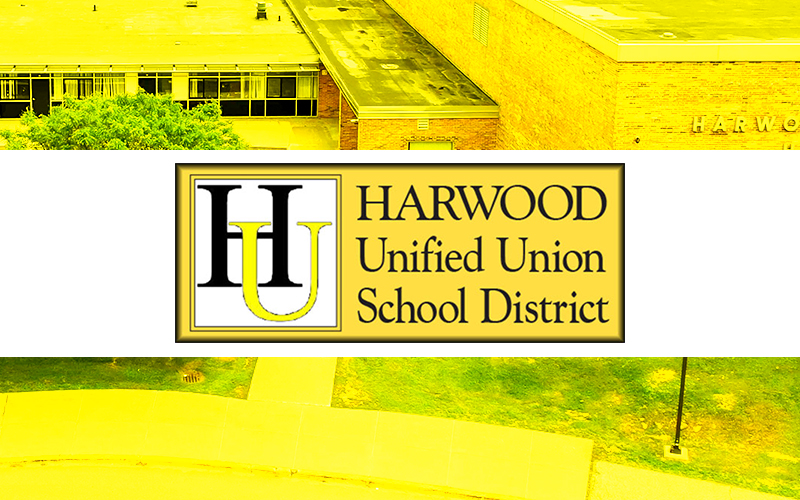The Harwood Unified Union School District (HUUSD) administration is already preparing to ramp up its in-person school days. At a school board meeting on September 9, Superintendent Brigid Nease met with HUUSD Board members to share an update on the first day of school and to talk about the administration’s plan to transition to more in-person school days.
“Our careful planning really paid off,” said Nease about the first day of school. “I couldn’t be more proud of our staff and administration. Students were flexible, they were patient, they were kind. They wore their masks well.”
Students in the Harwood Unified Union School District will be returning to the classroom two days a week starting on September 21. Schools will continue to operate at 50% capacity with half of the students in the classrooms on Monday and Tuesday and then remote Wednesday through Friday. The other half of the students will be in-person on Thursday and Friday and remote Monday through Wednesday. Teachers will be in the classroom four days a week and all learning will be remote on Wednesdays.
Nease told board members about the successes and failures of the first day of school for each school in the district, as reported by each school’s principal. In Warren, students were happy and screening went well. Everyone showed up; there were no attendance issues. However, there were technological issues with iPads. Regarding health safety, one student was sent home after drop-off because they didn’t pass a screening.
In Fayston, families were accommodating to new regulations, and students were happy to be at school. There was one missed bus stop and some new rituals took longer than planned. Fayston Elementary School staff told Nease that screening took way too long. Staff are also concerned about carrying out the screening process as the weather turns colder.
In Waitsfield, all students made it into school by 8 a.m. Screening didn’t take as long as expected. During screening, a few students were sent home because of travel out of state. In school, Waitsfield staff ran into challenges delivering meals in a timely fashion. Staff also reported challenges keeping students socially distanced.
In Moretown, arrival and dismissal worked well and breakfast and lunch were delivered efficiently. Staff and student attendance were high, but two students were sent home after screening.
At Thatcher Brook Primary School (TBPS) in Waterbury, all students were in the building by 8:15 a.m. According to TBPS principal Denise Goodnow, staff got 150 students into the building in 45 minutes while Vermont State Police controlled traffic. After screening, two students were sent home. Attendance was high, with only two students and one staff member absent. The only major problem were traffic issues at the end of the day, as over 100 cars came to pick up students.
At Crossett Brook Middle School (CBMS) in Duxbury, principal Tom Drake reported that mask breaks were needed. Attendance was high, with only two absences. Every student passed screening and nobody had to be sent home.
Harwood Union High School and Middle School in Duxbury experienced bus congestion at the start of school. There was a problem with the calibration of thermometers in which temperatures had to be taken more than once. In the high school, 26 students were absent. While teaching worked out for the first day, staff were concerned about the lack of substitute teachers. “Our list of substitute teachers is woefully low,” admitted Nease.
The HUUSD’s remote learning academy also had a good first day. Currently there are 145 students enrolled in the district’s fully remote academy. Ninety-seven of those students are in grades preK through sixth. Twenty-two are in seventh and eighth grade, and 26 are in high school. “The remote academy has come together well,” said Nease.
At the meeting, Nease also told board members about the administration’s latest plans to ramp up in-person school days, provided that there is not a major coronavirus outbreak in the district.
“We’ve developed a set of metrics that we’re collecting data on, and we have every expectation that on Monday the week of September 21, we are going to move into what we call the 2-2-1 model. Group A will go to school on Monday and Tuesday, everyone will be remote on Wednesday, and group B will go to school on Thursday and Friday,” said Nease.
From there, the administration will rely on guidance from the state and local school health outcomes before deciding whether or not to send preK through fourth-graders to school four days a week. “The week of October 5 and 12, we would collect all the data and we would know where we are with the virus transmission in the state. The week of October 19, we would begin four days in person for preK through four,” said Nease.
Nease explained that the administration’s decision to send younger students to school for more in-person days before older students revolves around state coronavirus safety guidelines. “Health and guidance criteria changed to allow us, as long as students are masked, to be between 3 to 6 feet for ages under 10 years old. Students 10 years and up must be masked and 6 feet apart when indoors. And we do not have the capacity to bring all students in five days a week and have them remain 6 feet apart in all these schools,” said Nease.







